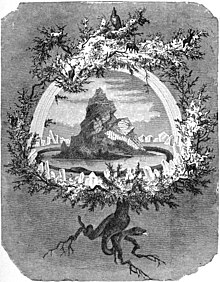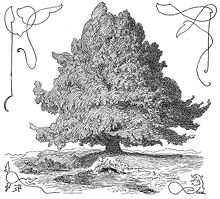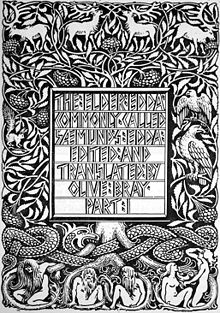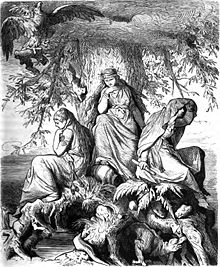
Ægir, Hlér, or Gymir, is a jötunn and a personification of the sea in Norse mythology. In the Old Norse record, Ægir hosts the gods in his halls and is associated with brewing ale. Ægir is attested as married to a goddess, Rán, who also personifies the sea, and together the two produced daughters who personify waves, the Nine Daughters of Ægir and Rán, and Ægir's son is Snær, personified snow. Ægir may also be the father of the beautiful jötunn Gerðr, wife of the god Freyr, or these may be two separate figures who share the same name.
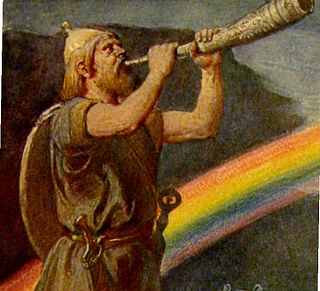
In Norse mythology, Bifröst, also called Bilröst, is a burning rainbow bridge that reaches between Midgard (Earth) and Asgard, the realm of the gods. The bridge is attested as Bilröst in the Poetic Edda, compiled in the 13th century from earlier traditional sources; as Bifröst in the Prose Edda, written in the 13th century by Snorri Sturluson; and in the poetry of skalds. Both the Poetic Edda and the Prose Edda alternately refer to the bridge as Ásbrú.

Fenrir or Fenrisúlfr, also referred to as Hróðvitnir and Vánagandr, is a monstrous wolf in Norse mythology. In Old Norse texts, Fenrir plays a key role during the events of Ragnarök, where he is foretold to assist in setting the world aflame, resulting in the collapse of humanity and society, and kill the god Odin.

In Norse mythology, Heimdall is a god. He is the son of Odin and nine mothers. Heimdall keeps watch for invaders and the onset of Ragnarök from his dwelling Himinbjörg, where the burning rainbow bridge Bifröst meets the sky. He is attested as possessing foreknowledge and keen senses, particularly eyesight and hearing. The god and his possessions are described in enigmatic manners. For example, Heimdall is golden-toothed, "the head is called his sword," and he is "the whitest of the gods."
In Norse mythology, Hvergelmir is a major spring. Hvergelmir is attested in the Poetic Edda, compiled in the 13th century from earlier traditional sources, and the Prose Edda, written in the 13th century by Snorri Sturluson. In the Poetic Edda, Hvergelmir is mentioned in a single stanza, which details that it is the location where liquid from the antlers of the stag Eikþyrnir flow, and that the spring, "whence all waters rise", is the source of numerous rivers. The Prose Edda repeats this information and adds that the spring is located in Niflheim, that it is one of the three major springs at the primary roots of the cosmic tree Yggdrasil, and that within the spring are a vast amount of snakes and the dragon Níðhöggr.

In Norse mythology, Ragnarök is a foretold series of impending events, including a great battle in which numerous great Norse mythological figures will perish ; it will entail a catastrophic series of natural disasters, including the burning of the world, and culminate in the submersion of the world underwater. After these events, the world will rise again, cleansed and fertile, the surviving and returning gods will meet, and the world will be repopulated by two human survivors, Líf and Lífþrasir. Ragnarök is an important event in Norse mythology and has been the subject of scholarly discourse and theory in the history of Germanic studies.
In Norse mythology, Níðhöggr is a dragon who gnaws at a root of the world tree, Yggdrasil. In historical Viking society, níð was a term for a social stigma, implying the loss of honor and the status of a villain. Thus, its name might refer to its role as a horrific monster in its action of chewing the corpses of the inhabitants of Náströnd: those guilty of murder, adultery, and oath-breaking.

Mímir or Mim is a figure in Norse mythology, renowned for his knowledge and wisdom, who is beheaded during the Æsir–Vanir War. Afterward, the god Odin carries around Mímir's head and it recites secret knowledge and counsel to him.

In Norse mythology, the einherjar are those who have died in battle and are brought to Valhalla by valkyries. In Valhalla, the einherjar eat their fill of the nightly resurrecting beast Sæhrímnir, and valkyries bring them mead from the udder of the goat Heiðrún. The einherjar prepare daily for the events of Ragnarök, when they will advance for an immense battle at the field of Vígríðr.
In Norse mythology, Hoddmímis holt is a location where Líf and Lífþrasir are foretold to survive the long winters of Fimbulvetr. Hoddmímis holt is attested in the Poetic Edda, compiled in the 13th century from earlier traditional sources, and the Prose Edda, written in the 13th century by Snorri Sturluson. Like the very similarly named Mímameiðr, scholars generally consider Hoddmímis holt to be another name for Yggdrasil and connect it to folklore recorded from continental Germanic folklore.

In Norse mythology, Óðr or Óð, sometimes anglicized as Odr or Od, is a figure associated with the major goddess Freyja. The Prose Edda and Heimskringla, written in the 13th century by Snorri Sturluson, both describe Óðr as Freyja's husband and father of her daughter Hnoss. Heimskringla adds that the couple produced another daughter, Gersemi. A number of theories have been proposed about Óðr, generally that he is a hypostasis of the deity Odin due to their similarities.

In Norse mythology, Surtr, also sometimes written Surt in English, is a jötunn. He is the guardian of Muspelheim which is along with Niflheim, the only two realms to exist before the beginning of time, and the greatest of the fire giants. Surtr is attested in the Poetic Edda, compiled in the 13th century from earlier traditional sources, and the Prose Edda, written in the 13th century by Snorri Sturluson. In both sources, Surtr is foretold as being a major figure during the events of Ragnarök; carrying his bright sword, he will go to battle against the Æsir, he will battle the major god Freyr, and afterward the flames that he brings forth will engulf the Earth.

Urðarbrunnr is a well in Norse mythology. Urðarbrunnr is attested in the Poetic Edda, compiled in the 13th century from earlier traditional sources, and the Prose Edda, written in the 13th century by Snorri Sturluson. In both sources, the well lies beneath the world tree Yggdrasil, and is associated with a trio of norns. In the Prose Edda, Urðarbrunnr is cited as one of three wells existing beneath three roots of Yggdrasil that reach into three distant, different lands; the other two wells being Hvergelmir, located beneath a root in Niflheim, and Mímisbrunnr, located beneath a root near the home of the frost jötnar. Scholarly theory and speculation surrounds the well.

Máni is the Moon personified in Germanic mythology. Máni, personified, is attested in the Poetic Edda, compiled in the 13th century from earlier traditional sources, and the Prose Edda, written in the 13th century by Snorri Sturluson. Both sources state that he is the brother of the personified sun, Sól, and the son of Mundilfari, while the Prose Edda adds that he is followed by the children Hjúki and Bil through the heavens. As a proper noun, Máni appears throughout Old Norse literature. Scholars have proposed theories about Máni's potential connection to the Northern European notion of the Man in the Moon, and a potentially otherwise unattested story regarding Máni through skaldic kennings.

Norse cosmology is the account of the universe and its laws by the ancient North Germanic peoples. The topic encompasses concepts from Norse mythology, such as notations of time and space, cosmogony, personifications, anthropogeny, and eschatology. Like other aspects of Norse mythology, these concepts are primarily recorded from earlier oral sources in the Poetic Edda, a collection of poems compiled in the 13th century, and the Prose Edda, authored by Icelander Snorri Sturluson in the 13th century. Together these sources depict an image of Nine Worlds around a cosmic tree, Yggdrasil.

Sól or Sunna is the Sun personified in Germanic mythology. One of the two Old High German Merseburg Incantations, written in the 9th or 10th century CE, attests that Sunna is the sister of Sinthgunt. In Norse mythology, Sól is attested in the Poetic Edda, compiled in the 13th century from earlier traditional sources, and the Prose Edda, written in the 13th century by Snorri Sturluson.

In Norse mythology, Líf and Lífþrasir, sometimes anglicized as Lif and Lifthrasir, female and male respectively, are two humans who are foretold to survive the events of Ragnarök by hiding in a wood called Hoddmímis holt and, after the flames have abated, to repopulate the newly risen and fertile world. Líf and Lífþrasir are mentioned in the Poetic Edda, which was compiled in the 13th century from earlier traditional sources, and the Prose Edda, written in the 13th century by Snorri Sturluson. Many scholars have speculated as to the underlying meaning and origins of both names.
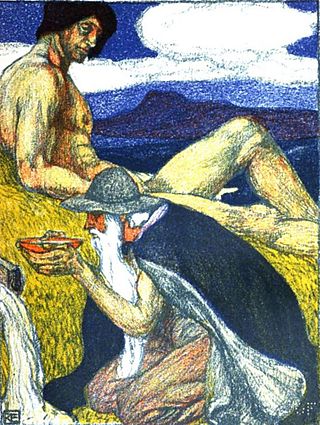
In Norse mythology, Mímisbrunnr is a well associated with the being Mímir, located beneath the world tree Yggdrasil. Mímisbrunnr is attested in the Poetic Edda, compiled in the 13th century from earlier traditional sources, and the Prose Edda, written in the 13th century by Snorri Sturluson. The well is located beneath one of three roots of the world tree Yggdrasil, a root that passes into the Jötunheimr where the primordial plane of Ginnungagap once existed. In addition, the Prose Edda relates that the water of the well contains much wisdom, and that Odin sacrificed one of his eyes to the well in exchange for a drink. In the Prose Edda, Mímisbrunnr is mentioned as one of three wells existing beneath three roots of Yggdrasil, the other two being Hvergelmir, located beneath a root in Niflheim, and Urðarbrunnr.

In Norse mythology, the Æsir–Vanir War was a conflict between two groups of deities that ultimately resulted in the unification of the Æsir and the Vanir into a single pantheon. The war is an important event in Norse mythology, and the implications for the potential historicity surrounding accounts of the war are a matter of scholarly debate and discourse.
In Norse mythology, Mímameiðr is a tree whose branches stretch over every land, is unharmed by fire or metal, bears fruit that assists pregnant women, and upon whose highest bough roosts the cock Víðópnir. Mímameiðr is solely attested in the Old Norse poem Fjölsvinnsmál. Due to parallels between descriptions of the two, scholars generally consider Mímameiðr to be another name for the world tree Yggdrasil, along with the similarly named Hoddmímis holt, a wood within which Líf and Lífthrasir are foretold to take refuge during the events of Ragnarök. Mímameiðr is sometimes modernly anglicized as Mimameid or Mimameith.
